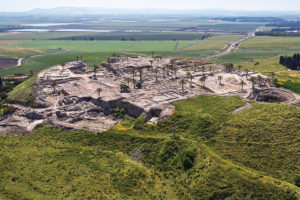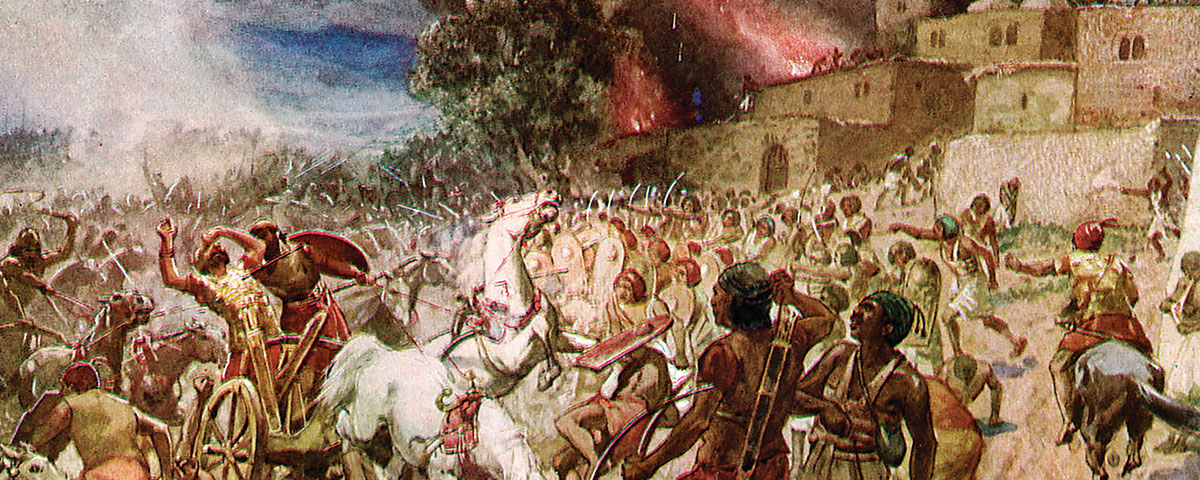Megiddo, in Israel’s Jezreel Valley, is among the most fought-over pieces of ground in history. The world’s great armies have waged 34 known battles across the terrain surrounding the base of Tel Megiddo, the hilltop settlement dating from 7000 bc. It is the site of history’s first reliably recorded battle, when in 1457 bc Egyptians under Pharaoh Thutmose III defeated a coalition of Canaanite tribes. Many people also believe Megiddo will host history’s last great battle, a climactic clash between the forces of good and evil at the place the New Testament Book of Revelation calls by its Greek name—Armageddon.

In an age when merchants transported almost all trade goods on the backs of camels and horses, Megiddo was strategic terrain in every sense of the term. From its position on the western edge of the Jezreel Valley this high ground dominated the narrow Musmus Pass on the Via Maris, a primary overland trade route in ancient and early medieval times. It linked Egypt with Asia Minor (present-day Turkey) and Mesopotamia’s Fertile Crescent (present-day Iraq). Branches of the fabled Silk and Spice roads ran through the Jezreel along the Via Maris.
Battles since lost to the mists of time were undoubtedly fought there before 1457 bc. Fragmentary inscriptions on ancient Egyptian tombs strongly suggest that in 2350 bc forces under Pharaoh Pepi I defeated Canaanite rebels at the Nose of the Gazelle’s Head, a landmark historians have placed somewhere in the Mount Carmel coastal range, just a few miles northwest of Megiddo.
The Old Testament records five key clashes around Megiddo. In 1285 bc the Israelite prophet Deborah and her military counterpart, Barak, sent Canaanite General Sisera packing in battle near Mount Tabor, 21 miles northeast of Megiddo. Sisera kept running until a turncoat drove a tent peg through his skull. Forty years later a band of 300 Israelites under the prophet and commander Gideon routed a greatly superior Midianite army at the Hill of Moreh, just east of Megiddo. In 1055 bc Saul, first king of a united Israel, lost the battle, his life, his head and three sons to the Philistines at Mount Gilboa, 20 miles southeast of Megiddo, leaving son-in-law David as king. In 841 bc the Israelite captain Jehu staged a coup against King Joram, piercing his heart with an arrow in a chariot duel just east of Megiddo before having his mother, the infamous Queen Jezebel, thrown from a window to her death in Jezreel. Finally, in 609 bc Egyptian Pharaoh Necho II defeated and killed King Josiah of Judah (opposite, in lead chariot) in battle at Megiddo and turned the southern kingdom into a vassal state.
Tel Megiddo was abandoned in 586 bc, about the time Babylonian King Nebuchadnezzar II besieged Jerusalem, overran Judah and sent many survivors into the infamous “Babylonian captivity.” But over the subsequent two and a half millennia the fighting has continued on the plain surrounding Megiddo. In ad 67, during the Jewish Revolt against Rome, future emperor Vespasian routed a rebel force at Mount Tabor. In 1182 and again in 1187 Sultan Saladin of Egypt and Syria defeated the Crusaders at Mount Tabor, though in 1183 he cut and ran at Ain Jalut (present-day Ein Harod, Israel), between Megiddo and Mount Gilboa. The Egyptian Mamluks defeated a force of invading Mongols at Ain Jalut in 1260, only to be thrashed themselves four years later by a combined Crusader force of Templers and Hospitallers at Lejjun, a mile east of the Tel Megiddo ruins.
In the modern era Napoléon Bonaparte turned around a French battle against Ottoman Turks at Mount Tabor in 1799, while in 1918 British General Edmund Allenby defeated a mixed force of Ottomans and Germans at Megiddo. Israel fought four distinct battles—two in 1948, one in 1967 and another in 1973—against Arab forces around Megiddo. Present-day Tel Megiddo (Armageddon) National Park [en.parks.org.il/ParksAndReserves/TelMegiddo] encompasses perhaps the most significant archeological site in Israel, where excavations have unearthed more than two-dozen layers of habitation stretching back to the early Bronze Age.
Peace may reign for the time being in Megiddo, but if the final battle between good and evil foretold in the New Testament comes to pass, it may not be confined to the surrounding plain. Since the end of World War II the name Armageddon has become synonymous with a potential global nuclear cataclysm. MH

